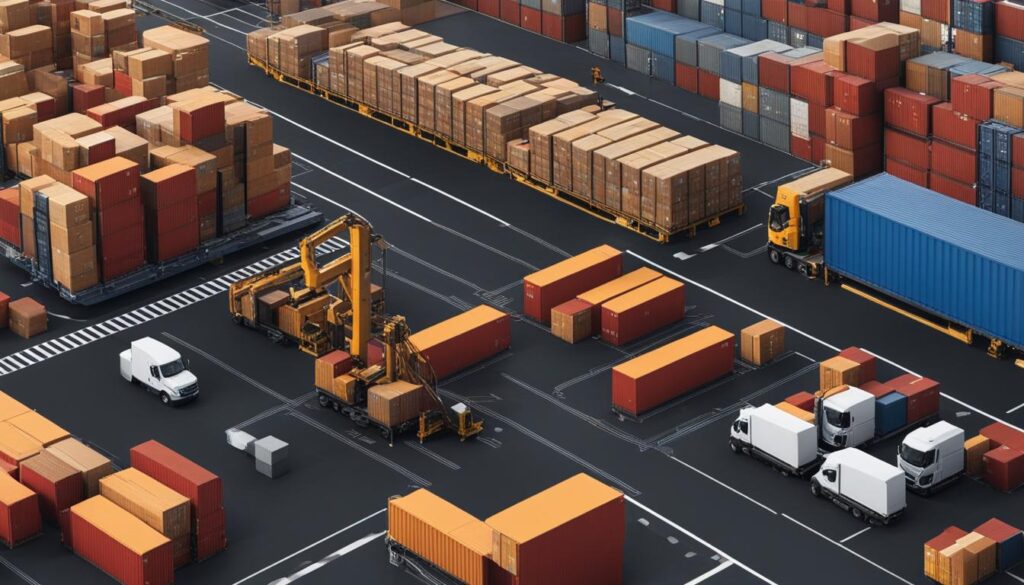Managing modern supply chains has become increasingly complex, involving numerous organizations, suppliers, and distributors across various stages and geographical locations. The emergence of Web 3.0, with its decentralized infrastructure and robust blockchain protocols, is revolutionizing the way supply chains operate.
Web 3.0, also known as web3, utilizes advancements like artificial intelligence, Internet of Things (IoT), and blockchain technology to establish transparent, secure, and automated systems for supply chain management. It enables seamless tracking, automated record keeping, verified supplier data, and the use of smart contracts to streamline operations, reduce delays, and ensure transparency and trust.
With the integration of Web 3.0 technologies, supply chains benefit from enhanced traceability, operational efficiency, and innovative tradability. From smart warehouse solutions to real-time compliance updates, the future of logistics is being shaped by the disruptive power of Web 3.0.
Key Takeaways:
- Web 3.0 utilizes blockchain, artificial intelligence, and IoT in supply chain management.
- It offers seamless tracking, automated record keeping, and verified supplier data.
- Web 3.0 ensures enhanced traceability, operational efficiency, and innovative tradability.
- Supply chains benefit from smart warehouse solutions and real-time compliance updates.
- The future of logistics is being shaped by the transformative power of Web 3.0.
What is Web3 in Supply Chain and Logistics?
Web3 in supply chain and logistics refers to the application of blockchain advancements and decentralized networks to establish transparent, secure, and automated systems for managing supply chains. It involves digitizing transactions, promoting provenance tracking, and fostering trust among supply chain participants.
Web3 technologies such as smart contracts and decentralized data management eliminate inefficiencies by streamlining international trade processes, reducing reliance on paperwork and intermediaries.
The key features of Web3 integrated supply chains include:
- Seamless Tracking: Web3 enables real-time tracking of goods and products throughout the supply chain, providing visibility and accountability at every stage.
- Automated Record Keeping: With Web3, supply chain data is automatically recorded, verified, and securely stored, reducing manual paperwork and ensuring accurate and reliable information.
- Verified Supplier Data: Web3 utilizes blockchain identity management to verify and authenticate supplier data, ensuring trust and transparency in the supply chain.
- Automation using Smart Contracts: Smart contracts enable automated execution of predefined conditions and actions, streamlining supply chain processes and reducing delays.
- Timestamping and Hashing for Data Integrity: Through cryptographic techniques, Web3 provides immutable timestamps and hashes to ensure data integrity and prevent tampering.
- Security Measures: Web3 incorporates robust security measures such as data encryption and authentication to protect sensitive supply chain information from unauthorized access.
- Digital Transaction Signing: Web3 enables digital signatures to validate ownership, ensuring secure and trustworthy transactions within the supply chain.
- Audit Trail for Documents: By recording every transaction on the blockchain, Web3 creates an immutable audit trail for documents, facilitating transparency, compliance, and dispute resolution.
“Web3 integrated supply chains streamline processes, reduce inefficiencies, and enhance transparency and trust among supply chain participants.”
By implementing Web3 technologies in supply chain and logistics, organizations can revolutionize their operations, unlocking new levels of efficiency, security, and collaboration.

In the next section, we will explore the key features of Web3 integrated supply chain and logistics in more detail.
Key Features of Web3 Integrated Supply Chain and Logistics
Web3 integrated supply chains offer several key features that significantly enhance the effectiveness and efficiency of supply chain and logistics operations. These features are designed to improve traceability, transparency, and overall supply chain management. Let’s explore some of the key features:
1. Seamless Tracking through Distributed Ledgers
Web3 employs distributed ledgers powered by blockchain technology to enable seamless tracking of products throughout the supply chain. This allows for real-time visibility and monitoring of goods, enabling stakeholders to track their location, condition, and status accurately.
2. Automated Record Keeping with Validation and Secure Storage
Web3 integrated supply chains automate record keeping processes, ensuring accurate and secure storage of critical data and documents. With blockchain-based validation mechanisms, there is improved data integrity, reducing the risk of errors and fraud.
3. Verified Supplier Data through Blockchain Identity Management
With Web3, supply chains can verify and authenticate supplier data using blockchain identity management systems. This feature ensures trustworthiness and reliability in supplier information, enhancing transparency and reducing the risk of counterfeit products.
4. Automation Using Smart Contracts Based on Predefined Conditions
Web3 leverages smart contracts to automate supply chain transactions based on predefined conditions. This automation eliminates manual intervention, streamlines processes, and reduces operational costs, while ensuring accuracy and timeliness.
5. Timestamping and Hashing for Data Integrity
To ensure the integrity and immutability of supply chain data, Web3 incorporates timestamping and hashing mechanisms. These features provide a robust framework for verifying the authenticity and accuracy of data, preventing unauthorized tampering.
6. Security Measures such as Data Encryption and Authentication
Web3 integrated supply chains prioritize data security by leveraging encryption and authentication techniques. This ensures that sensitive information remains protected, limiting unauthorized access and safeguarding against cyber threats.
7. Digital Transaction Signing for Ownership Validation
Web3 enables secure digital transaction signing, providing validation of ownership rights and facilitating seamless transfer of goods and assets. This feature enhances trust among supply chain participants and reduces the risk of fraudulent transactions.
8. Audit Trail for Documents
Web3 integrated supply chains maintain comprehensive audit trails for documents, ensuring transparency and accountability. These audit trails enable traceability of document revisions, approvals, and any changes made, enhancing governance and compliance.
These key features of Web3 integrated supply chain and logistics enable real-time monitoring, secure data management, trustworthy validation, automation of supply chain transactions, data integrity, enhanced security, seamless e-signing, and transparent record-keeping. By embracing Web3 technologies, businesses can revolutionize their supply chain and logistics operations, achieving greater efficiency, transparency, and competitiveness.

| Feature | Description |
|---|---|
| Seamless Tracking through Distributed Ledgers | Real-time visibility and monitoring of products throughout the supply chain. |
| Automated Record Keeping with Validation and Secure Storage | Automated and secure storage of critical data and documents. |
| Verified Supplier Data through Blockchain Identity Management | Authentication and verification of supplier information for increased transparency. |
| Automation Using Smart Contracts Based on Predefined Conditions | Automated supply chain transactions based on predefined rules and conditions. |
| Timestamping and Hashing for Data Integrity | Ensuring the authenticity and integrity of supply chain data. |
| Security Measures such as Data Encryption and Authentication | Ensuring the security and protection of sensitive supply chain information. |
| Digital Transaction Signing for Ownership Validation | Secure validation of ownership rights and facilitation of seamless transfers. |
| Audit Trail for Documents | Comprehensive record-keeping and traceability of document revisions and changes. |
Benefits of Web3 in Logistics and Supply Chain Management
Web3’s blockchain-based solutions offer numerous benefits to the realm of logistics and supply chain management. By leveraging Web3 technologies, businesses can achieve enhanced traceability, operational efficiency, transparency, and trust-building throughout their supply chains. Let’s explore some of the key advantages that Web3 brings to the table:
1. Enhanced Traceability and Operational Efficiency
Web3 ensures secure and efficient monitoring, enabling comprehensive traceability for transparent product information sharing. By leveraging blockchain’s decentralized ledger, businesses can track and verify the movement of goods, ensuring accountability and reducing the risk of fraud or counterfeiting.
2. Transparency and Trust Building
Web3 introduces transparency and trust within logistics and supply chain processes through verified supplier data and independent hash values. This fosters trust among all stakeholders, including consumers, as they gain confidence in the authenticity and quality of the products they purchase.
3. Innovative Tradability in Asset Management
With Web3, traditional marketplace dynamics are transformed through the tokenization of assets. This enables fractional ownership and real-time digital transfers, offering new opportunities for investment and asset management that were previously unimaginable.
4. Streamlined Product Recalls
Web3 accelerates product recall processes, leading to quicker responses, reduced costs, and safer products. By leveraging the decentralized nature of blockchain, businesses can efficiently identify and remove faulty or unsafe products from the market, protecting both their brand reputation and consumer safety.
5. Real-Time Compliance Updates
Regulatory compliance is crucial in logistics and supply chain management. Web3 plays a pivotal role in maintaining compliance by providing real-time updates to all stakeholders. This ensures that the supply chain adheres to relevant regulations and industry standards, avoiding costly penalties and legal issues.
By embracing Web3 technologies, businesses can unlock these benefits and revolutionize their logistics and supply chain management processes. The seamless integration of blockchain and decentralized networks brings unprecedented transparency, efficiency, and trust to the industry, setting the stage for a more secure and sustainable future.

The Impact of Web3 on Supply Chains and Logistics
Web3 has revolutionized supply chains and logistics, ushering in a new era of efficiency, security, and transparency. By leveraging blockchain technology and decentralized networks, Web3 transforms traditional processes into highly automated and seamless operations.
One key impact of Web3 is the introduction of explicit requirements for supply chains and automated processes. These requirements are based on predefined rules, ensuring smooth operations and fostering democratic governance. Now, supply chains can function with clarity and efficiency, adhering to established protocols and eliminating unnecessary delays or bottlenecks.
Another crucial aspect of Web3 is permissioned access, which allows authorized individuals to validate and certify supply chain activities. With this level of access, a regulated and secure environment is created, ensuring the integrity of the supply chain. Customers also benefit from this transparency, as they can securely examine product specifications and relevant data, gaining greater trust in the supply chain process.
Shared records are another significant impact of Web3 on supply chains and logistics. By utilizing blockchain technology, all participants share the same record, creating a transparent and efficient ecosystem. This eliminates discrepancies and duplications, streamlining processes and reducing the risk of errors or fraud.
Web3 networks also provide user-friendly tools for communication and information exchange, enhancing connectivity among supply chain participants. This fosters collaboration and improves coordination, resulting in smoother operations and better decision-making.
Supply chains and logistics integrate Web3 technologies in various ways, such as cryptocurrency payments, asset monitoring, provenance and certification, regulatory compliance, and peer-to-peer communication. These integrations further enhance the efficiency and effectiveness of supply chains, optimizing processes and minimizing risks.

In summary, the impact of Web3 on supply chains and logistics is significant and far-reaching. From transforming traditional processes into efficient and secure operations to promoting transparency and trust, Web3 has revolutionized the way supply chains operate. As businesses embrace Web3 technologies, they can benefit from enhanced efficiency, streamlined processes, and increased customer trust, positioning themselves at the forefront of the evolving supply chain landscape.
Conclusion
The integration of Web3 technologies into supply chain and logistics has revolutionized the industry, paving the way for a more transparent, efficient, and decentralized ecosystem. By leveraging seamless tracking, automated record keeping, verified supplier data, and smart contract automation, Web3 offers key features that optimize supply chains.
Not only does Web3 enhance traceability and transparency, but it also drives operational efficiency and enables innovative asset management and streamlined product recalls. With real-time compliance updates, businesses can ensure regulatory adherence and stay ahead of the game.
The impact of Web3 on supply chains and logistics is transformative. It fosters trust, collaboration, and resilience, transforming traditional processes into more efficient and secure operations. As businesses look toward the future, investing in education, collaborating on innovation, and adopting a phased approach to technology integration are essential to harness the full potential of Web3 and drive sustainable growth.
In summary, the integration of Web3 technologies opens up opportunities for a more efficient, sustainable, and transparent future for global supply chain management. By embracing Web3, businesses can navigate the evolving landscape, optimize operations, and stay competitive in an increasingly digital world.
FAQ
How does Web 3.0 transform supply chain dynamics?
Web 3.0, with its decentralized infrastructure and robust blockchain protocols, addresses the complexities of modern supply chains by facilitating secure data sharing, reducing delays and inconsistencies, and revolutionizing logistics and supply chain management.
What is Web3 in supply chain and logistics?
Web3 in supply chain and logistics refers to the application of blockchain advancements and decentralized networks to establish transparent, secure, and automated systems for managing supply chains. It digitizes transactions, promotes provenance tracking, and fosters trust among supply chain participants.
What are the key features of Web3 integrated supply chain and logistics?
The key features of Web3 integrated supply chains include seamless tracking through distributed ledgers, automated record keeping with validation and secure storage, verified supplier data through blockchain identity management, automation using smart contracts based on predefined conditions, timestamping and hashing for data integrity, security measures such as data encryption and authentication, digital transaction signing for ownership validation, and audit trail for documents.
What are the benefits of Web3 in logistics and supply chain management?
The benefits of Web3 in logistics and supply chain management include enhanced traceability and operational efficiency, transparency and trust building, innovative tradability in asset management, streamlined product recalls, and real-time compliance updates.
What is the impact of Web3 on supply chains and logistics?
Web3 has a profound impact on supply chains and logistics, transforming traditional processes into more efficient and secure operations. It introduces explicit requirements for supply chains, automated processes based on predefined rules, permissioned access for validation and certification, transparent product specifications, shared records, user-friendly tools for communication and information exchange, and integration through cryptocurrency payments, asset monitoring, provenance and certification, regulatory compliance, and peer-to-peer communication.








